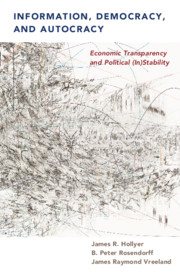Book contents
- Frontmatter
- Dedication
- Contents
- Figures
- Tables
- Acknowledgments
- 1 A New Approach to the Study of Transparency
- PART I FACETS OF TRANSPARENCY
- PART II POLITICAL (IN)STABILITY
- 5 Transparency and (In)stability: The Theory
- 6 The Evidence: Examples and Descriptive Data
- 7 The Evidence: Regression Analyses
- PART III WHY DISCLOSE
- CONCLUSION
- References
- Name Index
- Subject Index
6 - The Evidence: Examples and Descriptive Data
from PART II - POLITICAL (IN)STABILITY
Published online by Cambridge University Press: 17 September 2018
- Frontmatter
- Dedication
- Contents
- Figures
- Tables
- Acknowledgments
- 1 A New Approach to the Study of Transparency
- PART I FACETS OF TRANSPARENCY
- PART II POLITICAL (IN)STABILITY
- 5 Transparency and (In)stability: The Theory
- 6 The Evidence: Examples and Descriptive Data
- 7 The Evidence: Regression Analyses
- PART III WHY DISCLOSE
- CONCLUSION
- References
- Name Index
- Subject Index
Summary
Collapsing political regimes bring down with them a hail of uncertainty and can wreak havoc on the lives of citizens, not to mention financial markets. Accordingly, the field of comparative politics has devoted much attention to studying regime transitions. With such an abundance of scholarship apportioned to the topic, debates rage about nearly every aspect of the phenomenon: the causes of autocratic failure, the emergence of democracy, the survival and breakdown of democracy, even the very categories of political regime and how to define a regime transition.
This chapter focuses on the empirical effect of transparency on political stability. We seek to test the specific hypotheses generated by our autocratic and democratic models of Chapter 5. Fully engaging all of the debates surrounding political stability lies beyond the purview of our project. Instead, we accommodate, to an extent, alternative perspectives by testing our theory in different empirical contexts, thus avoiding the need to take sides. This chapter shows that when we control for factors prominent in the scholarly literature, our conclusions about the effects of transparency on political stability hold.
The HRV index proxies as an empirical measure of the concept of transparency in our theoretical models. Recall that in Chapter 5, transparency enters our models as the inverse of the standard deviation of the publicly observable signal of government performance witnessed by all citizens, σs. Our concept of transparency thus pertains to information that is (1) publicly observable – and known to be publicly observable by all actors – and (2) allows citizens to draw accurate inferences regarding government performance. The HRV index, based on the reporting/non-reporting of information to the World Bank's World Development Indicators (WDI) data series, mirrors our criteria. The disclosure of economic information to the World Bank reflects the public dissemination of credible data.
Of course, we do not expect many members of the public to seek access to such data directly from the World Bank. Instead, the public more likely obtains such information straight from the government or through domestic news reports informed by government disclosures. What then is the advantage of World Bank data?
- Type
- Chapter
- Information
- Information, Democracy, and AutocracyEconomic Transparency and Political (In)Stability, pp. 140 - 171Publisher: Cambridge University PressPrint publication year: 2018



